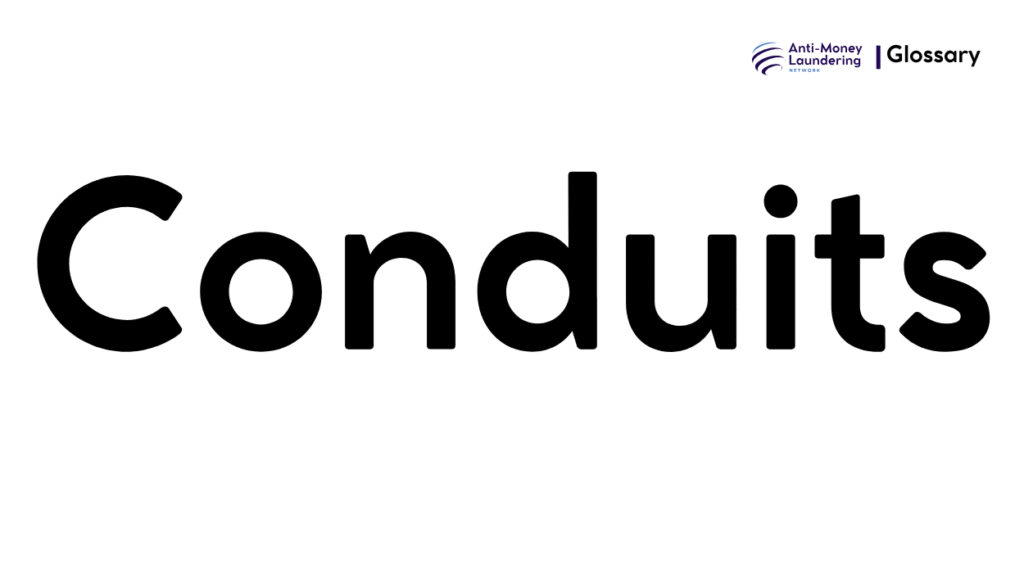Definition
In AML, Conduits refer to intermediaries, entities, or mechanisms used to transfer, hide, or facilitate the movement of illicit funds, often disguising their illegal origin to integrate them into the legitimate financial system. Conduits can be individuals, businesses, or financial instruments that act as channels to move money across borders or within financial networks in a way that circumvents detection or regulatory scrutiny.
Purpose and Regulatory Basis
Role in AML
Conduits play a critical role in the layering and integration stages of money laundering by complicating the traceability of unlawful funds. Identifying conduits helps break the chain of illicit financial flows, exposing underlying criminal activities.
Why it Matters
Detecting conduits is vital to prevent criminals from exploiting financial systems, protecting the integrity of markets and complying with legal obligations.
Key Regulations
- Financial Action Task Force (FATF) Recommendations: Emphasize the identification and monitoring of suspicious intermediaries.
- USA PATRIOT Act: Mandates financial institutions to implement enhanced due diligence on correspondent accounts and entities acting as conduits.
- EU Anti-Money Laundering Directives (AMLD): Require transparency on beneficial ownership and scrutiny of transfer mechanisms to prevent misuse.
When and How it Applies
Real-World Use Cases
- Use of shell companies as conduits to obscure ownership.
- Trade-based laundering using legitimate business invoices as conduits for illicit funds.
- Art and antiquities sales exploited as conduits for layering money.
Triggers and Examples
Transfers through third-party financial service providers or frequent account activity inconsistent with known customer profiles may indicate conduit use.
Types or Variants
Forms of Conduits
- Legal Entities: Shell companies, trusts, or foundations.
- Financial Instruments: Money orders, prepaid cards, and correspondent bank accounts.
- Commercial Channels: Trade-based conduits involving falsified invoices or misrepresented goods.
Examples
- A company issuing multiple wire transfers that pass through various jurisdictions.
- A money services business channeling funds without sufficient transparency.
Procedures and Implementation
Compliance Steps
- Establish Know Your Customer (KYC) protocols to identify potential conduits.
- Monitor transactions for patterns indicative of conduit activity.
- Utilize technology solutions for transaction screening and behavioral analytics.
- Conduct enhanced due diligence for high-risk intermediaries.
- Train staff to recognize conduit-related red flags.
Systems and Controls
- Automated transaction monitoring systems.
- Cross-department communication on suspicious conduit activity.
- Documentation and audit trails to trace conduit involvement.
Impact on Customers/Clients
- Customers involved, knowingly or unknowingly, with conduits may face additional scrutiny, delays, or restrictions.
- Institutions must balance compliance with fair treatment, ensuring customer rights while enforcing AML controls.
Duration, Review, and Resolution
- Institutions should continuously review conduit risks and transaction histories.
- Periodic audits ensure controls remain effective.
- Resolution may include filing Suspicious Activity Reports (SARs) and cooperating with authorities.
Reporting and Compliance Duties
- Financial entities must report suspicious conduit-related activities.
- Maintain comprehensive records for regulatory reviews.
- Failure to act can result in penalties, fines, and reputational damage.
Related AML Terms
- Placement, Layering, Integration: Conduits are heavily linked to layering and integration stages.
- Beneficial Ownership: Identifying the true owners behind conduits.
- Correspondent Banking: Often scrutinized as potential conduit channels.
Challenges and Best Practices
Common Issues
- Complex corporate structures obscuring conduit identity.
- Rapid evolution of financial technologies creating new conduits.
Best Practices
- Employ risk-based approaches focusing on high-risk conduit scenarios.
- Leverage AI and machine learning for pattern recognition.
- Continuous staff training and regulatory updates.
Recent Developments
- Increasing use of cryptocurrencies and digital assets as conduits.
- Regulatory emphasis on transparency and cross-border cooperation to combat conduit misuse.
- Adoption of blockchain analysis tools enhancing conduit detection.
Conduits represent pivotal elements in the process of money laundering. Effective identification and management of conduits allow financial institutions to disrupt illicit fund flows, ensure regulatory compliance, and uphold the integrity of the global financial system. For compliance officers, understanding conduits in AML is indispensable to developing robust detection, prevention, and reporting frameworks.

